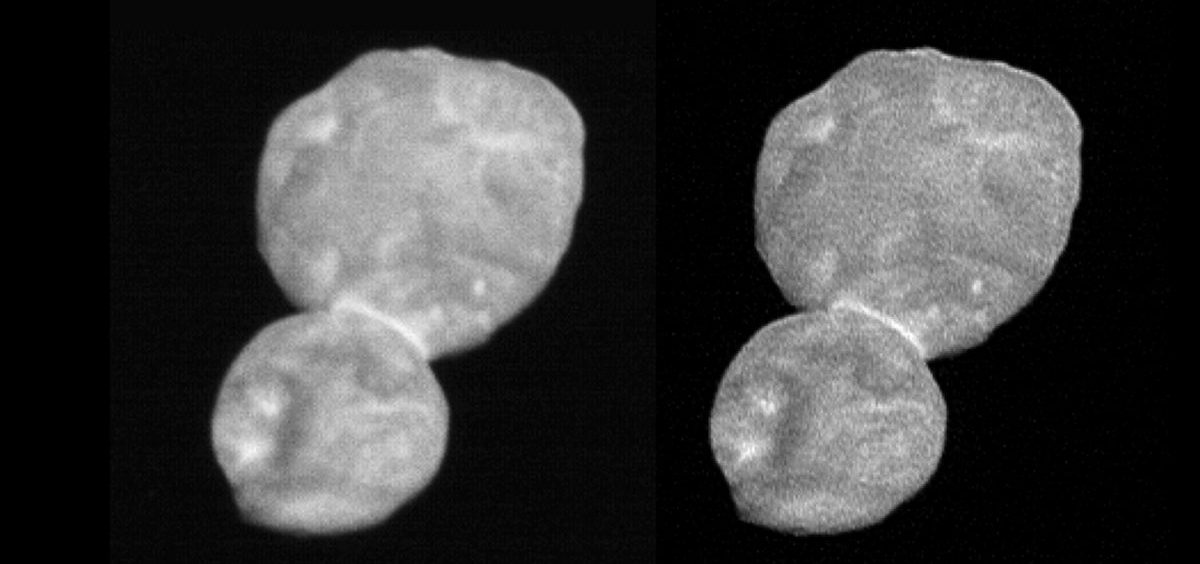News

Images Reveal A ‘Snowman’ At The Frigid Outer Reaches Of Our Solar System
By: Nell Greenfieldboyce | NPR
Posted on:
New images of a mysterious world at the far reaches of our solar system show that it’s shaped much like a snowman, with one large icy sphere attached to a smaller one.
The shape indicates that a rotating cloud of innumerable tiny objects must have coalesced into two balls that slowly spiraled closer and closer together until they gently touched, forming the object out beyond Pluto that scientists have nicknamed “Ultima Thule,” which means “beyond the known world.”
The same kind of accretion process produced the other moons and planets of the solar system around 4.5 billion years ago, says Jeff Moore, a co-investigator on NASA’s New Horizons mission. He explains that Ultima Thule appears to be a basic planetary building block that was left over and is still lying around “the backyard of the solar system.”
“We think what we are looking at is perhaps the most primitive object that has yet been seen by any spacecraft,” Moore says, “and may represent a class of objects which are the oldest and most primitive objects that can be seen anywhere in the present solar system.”
This strange, cold world is also the most distant object ever to be approached by a spacecraft. It lies some 4 billion miles from the sun, and it’s pretty tiny — only about 20 miles long and 10 miles wide. Before Ultima Thule was intercepted by the New Horizons spacecraft, scientists knew almost nothing about it, but they were eager for a glimpse of what’s thought to be an almost unchanged relic from our solar system’s earliest days.
Images were taken by onboard instruments as the spacecraft zoomed past the world some 2,200 miles from its surface just after midnight on New Year’s Day. Scientists have had to wait for the data to come back, a slow process that will continue in the days and months ahead.
“We have far less than 1 percent of the data that’s stored aboard the solid state recorders,” says Alan Stern, principal investigator of NASA’s New Horizons mission. Still, researchers have learned a lot already.
“It’s two completely separate objects that are now joined together,” says Stern, who explained that the larger lobe is now being referred to as “Ultima” and the smaller one is called “Thule.”
Ultima Thule has a mottled appearance, with no obvious impact craters, and is dark red. “This is very dark. This is like potting soil. This is a very dark object,” says Cathy Olkin, the mission’s deputy project scientist.
The narrow “neck” between the two lobes appears to be relatively bright, perhaps suggesting that particular materials might have settled there.
The New Horizons probe, about the size of a piano, has been flying through space for more than a dozen years, and provided the first-ever close-up of Pluto in 2015.
From the beginning, the mission always planned to fly by another object in the solar system’s Kuiper belt, which is filled with thousands of small, icy bodies. But it wasn’t until 2014 that the Hubble Space Telescope discovered this one, which could be reached with the spacecraft’s remaining fuel.
“I’m surprised that more or less picking one Kuiper belt object out of the hat, that we were able to get such a winner as this,” Stern says. “It’s going to revolutionize our knowledge of planetary science.”
9(MDI4ODU1ODA1MDE0ODA3MTMyMDY2MTJiNQ000))

